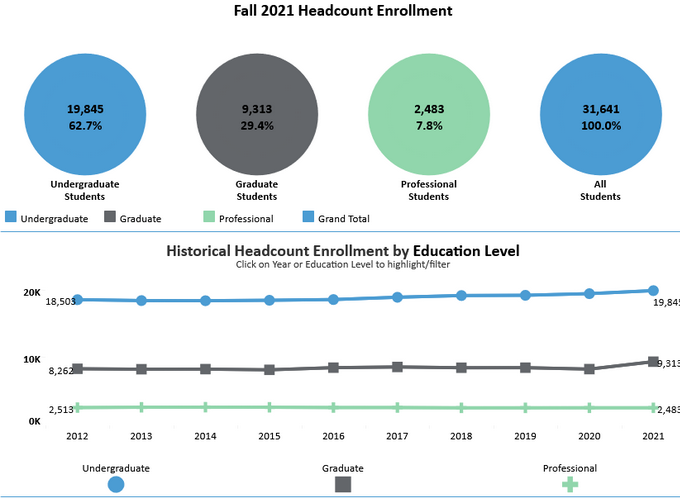Over the past two days, we’ve attended two public information meetings that the Town of Chapel Hill has hosted to talk about missing middle housing — duplexes, cottage homes, and the like.
As we’ve said earlier, we’re really excited about this — it will be really great for seniors, young families, and multi-generational households to have more housing choices near work, school, and parks.
The speakers last night — not so excited. There’s a lot to say about these meetings — and we plan to write more — but wanted to get out a quick fact check out this morning about one of the more egregious misstatements said about our student population.
The speaker in question posited that UNC has added 8,000 students over the past decade and that this raises “the prospect of a majority of the housing being transferred into student housing.”
That seemed…not at all accurate.
So we headed to the dashboard created by the Office of Institutional Research and Assessment at UNC. They keep track of things like enrollment and also maintain a historic headcount, which means we can see how many people have been enrolled over the past decade. Let’s look at the data from 2011 to 2021, the last year with data available.
| 2011 | 2021 | Difference (2021-2011) | |
| Undergraduates | 18430 | 19845 | +1415 |
| Graduate Students | 8190 | 9313 | +1123 |
| Professional Students | 2517 | 2483 | -34 |
| Total | +2504 |
UNC, our public flagship university, grew by 2504 students from 2011 to 2021. We reached out to mathematicians at UNC who confirmed that, indeed, 2504 is much less than 8000.
Update: A reader notes that the numbers for graduate students also include both in-person and online-only students, none of whom live on campus (and many of whom don’t live in Chapel Hill.) UNC has many online-only master’s programs.

We wanted to see if this enrollment increase was consistent with trends at other public flagship universities. Urban Institute calculated that the 50 US public flagships increased their total student enrollment by 24 percent between 2000 and 2018. During the same time period, UNC’s total student enrollment increased by 20.66 percent, which is consistent with the national trend.
We also found data about student housing. In 2011, 63% of students lived off campus, an umbrella term that encompasses fraternity/sorority housing. In 2019 – the year before the pandemic affected student housing, 64% of students lived off campus. This trend was remarkably consistent until the COVID-19 pandemic. In 2020, almost all students (95%) lived off campus, and in 2021, 71.3% of students lived off campus. However, the pandemic clearly affected this data – many students chose to live at home (which is considered off campus) when classes were held remotely. 2022 data, which has not been released, will give us a better picture of trends.
What does this mean?
Chapel Hill is a college town, no matter how many people wish that weren’t the case. Students are human beings who, like everyone, deserve safe homes they can afford. And while we would like to see more housing built for students on campus, that is not an excuse for inaction on the part of the town.
Students have become a bogeyman in our housing debate, second only perhaps to evil, greedy developers (i.e., people who build homes). Students are unwanted in neighborhoods, but we also don’t want student apartment buildings outside of neighborhoods.
If UNC built a dorm tomorrow for 2,500 students, we will still need more housing (unless you believe people should live far from jobs and we should ignore the climate impacts of longer and longer commutes). North Carolina added 133,000 people last year, more than any state but Texas and Florida. And many of those are moving to the Triangle.
If we do not make room to accommodate our fair share of that growth, Chapel Hill will become less and less affordable. We can continue to stall, we can study the issue to death, we can fearmonger, and we can blame UNC for not fixing a problem that is primarily the result of conscious efforts of residents and elected officials to make Chapel Hill an exclusionary locale.
Or, we can simply start addressing the problem by enabling more people to live here.
